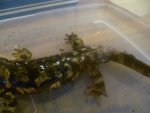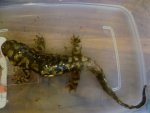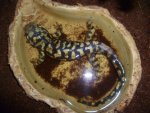spaceystacey
New member
- Joined
- Nov 16, 2011
- Messages
- 3
- Reaction score
- 0
Hi there!
I really hope someone can help! My tiger salamander has open wounds and white spots on his skin, (the white spots look hard and crusty) which I assume is a fungal infection?
I have had him for 2 years, I got him from someone else who got him from someone else so I have no idea how old he is.
He is kept in a glass tank with cocofibre husk as substrate, and moss in places, he also has a big water bowl which I change every other day, and he gets cleaned out every 4-6 weeks, the only thing that had changed recently is the position of his tank (about 2 months ago)
He had been hiding for about 3 weeks, when he surfaced he was thin, wrinkly and had these white spots on his body and tail, I bathed him in his water and saw that he was bleeding from a wound at the top of his tail, and he refused to eat (even waxworms and they are his favourite!)
I took him to the vets (general practice, not specialist) and she gave him an antibiotic injection and a salt water bath that she told me to keep him in for 3 days, also sent me home with some antibiotics and formula to try and get him eating but I couldnt get him to open his mouth!
After 3 days the white spots had gone, the original wound had started to heal but he had started to bleed from 3 other places on his back, I have put him back in his cage and the wounds are healing I think (he is not bleeding anymore), but he has white spots all over him again and some of them are raised (like bumps).
I bathed him for 2 hours in a salt water bath yesterday, and the white spots are gone, his back looks likes it healing.
I phoned the vet again and she wants me to give him oral anti-fungal treatment every day for 3 weeks! Any suggestions on how to get him to open his mouth - he is still refusing food!
Sorry for the overload in info, I just really want him to get better!!
Will try and add some photos.
Thanks Stacey
I really hope someone can help! My tiger salamander has open wounds and white spots on his skin, (the white spots look hard and crusty) which I assume is a fungal infection?
I have had him for 2 years, I got him from someone else who got him from someone else so I have no idea how old he is.
He is kept in a glass tank with cocofibre husk as substrate, and moss in places, he also has a big water bowl which I change every other day, and he gets cleaned out every 4-6 weeks, the only thing that had changed recently is the position of his tank (about 2 months ago)
He had been hiding for about 3 weeks, when he surfaced he was thin, wrinkly and had these white spots on his body and tail, I bathed him in his water and saw that he was bleeding from a wound at the top of his tail, and he refused to eat (even waxworms and they are his favourite!)
I took him to the vets (general practice, not specialist) and she gave him an antibiotic injection and a salt water bath that she told me to keep him in for 3 days, also sent me home with some antibiotics and formula to try and get him eating but I couldnt get him to open his mouth!
After 3 days the white spots had gone, the original wound had started to heal but he had started to bleed from 3 other places on his back, I have put him back in his cage and the wounds are healing I think (he is not bleeding anymore), but he has white spots all over him again and some of them are raised (like bumps).
I bathed him for 2 hours in a salt water bath yesterday, and the white spots are gone, his back looks likes it healing.
I phoned the vet again and she wants me to give him oral anti-fungal treatment every day for 3 weeks! Any suggestions on how to get him to open his mouth - he is still refusing food!
Sorry for the overload in info, I just really want him to get better!!
Will try and add some photos.
Thanks Stacey



